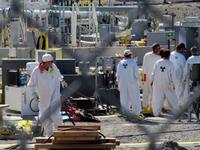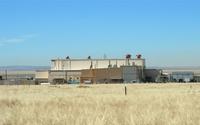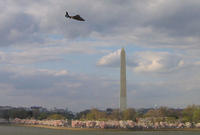-
Ohio’s Perry nuclear power plant was vulnerable to sabotage
A report issued last week said that operators at the Perry Nuclear Power Plant in Ohio found a vulnerability in the security of the plant last year, and that that vulnerability could have put the public in harm’s way. The utility operating the nuclear plant reported to the Nuclear Regulatory Commission (NRC) that the plant’s security program for monitoring underground pathways and other unattended openings were insufficient to detect and prevent unauthorized access to the protected area.
-
-
New radioactive waste repackaging facility in Los Alamos
The Los Alamos National Laboratory has brought a third waste repackaging facility online to increase its capability to process nuclear waste for permanent disposal. The box line facility is largest of its kind ever built.
-
-
U.S. nuclear industry resists stricter, post-Fukushima safety measures
Since the March 2011 Fukushima disaster, members of the Nuclear Regulatory Commission (NRC) have been debating whether or not to impose even stricter safety measures on the thirty-one U.S. boiling water reactors (BWRs). Utility companies have been fighting any new safety regulations, arguing that the security measures they have are more than enough.
-
-
Radioactive leaks at Washington’s Hanford nuclear reservation

Earlier this month, Washington Governor Jay Inslee announced that a radioactive waste tank at one of the nation’s most contaminated nuclear sites is leaking, bringing more bad news to Washington’s Hanford nuclear reservation. The 177 tanks at the plant, which hold millions of gallons of highly radioactive waste from plutonium production, are way past their intended 20-year life span.
-
-
Sandia Labs refurbishes nuclear security infrastructure

Sandia National Laboratories has completed $199 million in facilities construction and repair as part of an 11-year national effort to revitalize the physical infrastructure of nuclear security enterprise sites. The work is part of a program established in 2001 to reduce a long-standing backlog of deferred maintenance at the National Nuclear Security Administration’s (NNSA) eight sites, including Sandia.
-
-
Defusing the threat of ionizing radiation
The damage to Japan’s Fukushima nuclear reactor after the 2011 Tohoku earthquake raised concerns regarding U.S. preparedness to treat large-scale human exposure to ionizing radiation. Additionally, the immediate destructive potential of nuclear and radiological weapons, as well as their long-term health and economic impacts, continue to be of concern to DoD. Researchers look for novel approaches to mitigate immediate and long-term health damage from acute exposure to ionizing radiation and model its biophysical effects.
-
-
Idaho debating nuclear waste storage
For two decades, the Yucca mountain nuclear waste repository in Nevada was viewed as a long-term solution to the growing problem of radioactive waste generated by the 104 active nuclear power generation plants in the United States. One of the Obama administration’s first acts was to “defund” the project, in effect outing an end to it. States such as Texas, New Mexico, and North Carolina have fashioned their own interim solution to the problem of nuclear waste storage, and the governor of Idaho wants his state to follow these states’ example.
-
-
Part Three: Bechtel and the Y-12 security breach
With an annual security budget of $150 million, the Y-12 Nuclear Complex at Oakridge, Tennessee, prided itself on its high-tech security system built to protect more than 179 tons of uranium. After Sister Megan Rice, age 82, and two confederates, both senior citizens, too — the three were armed with nothing but wire cutters and flashlights — broke into the Y-12 facility on 28 July 2012, one security guard was fired. Numerous investigations and reports, however, show that last July’s incident was but one in a series of security failures and breaches at nuclear sites under the supervision of the National Nuclear Security Administration (NNSA). In May, Sister Rice and her aging collaborators will stand trial. Bechtel, a major contractor sharing responsibility for the documented security lapses at Y-12, has just received a federal nuclear plant security contract worth more than $22 billion.
-
-
Uranium mining debate divides Virginia
In Virginia a fight has begun over whether to drill for uranium. Some feel the drilling, which would create about 1,000 jobs and bounty of tax revenue in addition to nuclear fuel, is important for a state whose main industries, such as tobacco and textiles, are failing. Those who oppose the drilling fear the contamination of drinking water in case of an accident, and a stigma from uranium which would deter people and businesses from moving to the area.
-
-
Helicopter monitors radiation levels in Washington, D.C.

For the last week, a National Nuclear Security Administration (NNSA) helicopter has been flying over Washington, D.C., measuring naturally occurring radiation levels; the purpose is to establish a baseline of radiation levels so that abnormal spikes – occurring, for example, as a result of exploding a dirty bomb — may be readily detected
-
-
Critics: post-Fukushima nuclear power may be safer, but it is still not cost effective
The Southern Company wants to show its customers that it has learned from the Fukushima disaster in Japan and has protected its nuclear reactors to make sure the same thing does not happen in the United .States’ critics of nuclear power are not convinced – and also, they say, alternative energy sources, such as natural gas, are much cheaper to produce
-
-
Part One: Don’t blame the security guard at Y-12
On 28 July 2012, using only wire cutters and flashlights, peace activist Sister Susan Rice, 82 years of age, and two other confederates – both senior citizens themselves — successfully bypassed the elaborate, and expensive, security system around Y-12 National Security Complex at Oak Ridge, Tennessee; though the lone security guard at Y-12 has become a convenient scapegoat, it now appears that the breach reflects system-wide security and safety concerns at nuclear facilities under the National Nuclear Security Administration (NNSA); the breach is best understood as the end result of long standing management and organizational failures within and between DOE, NNSA, and NNSA’s private contractors; the NNSA, in fact, appears burdened by many of the same issues it was created in 2000 to resolve
-
-
Tetrapod robot developed for investigative, recovery work inside post-accident nuclear plants
Toshiba has developed a tetrapod robot able to carry out investigative and recovery work in locations which are too risky for people to enter; the multiple joints of its legs are controlled by a dedicated movement algorithm which enables the robot to walk on uneven surfaces, avoid obstacles, and climb stairs, securing access into areas which are challenging to be reached by wheeled robots or crawlers
-
-
Powerful debugging program to help U.S. nuclear deterrence
Lawrence Livermore National Laboratory (LLNL) researchers have used the Stack Trace Analysis Tool (STAT), a highly scalable, lightweight tool to debug a program running more than one million MPI processes on the IBM Blue Gene/Q (BGQ)-based Sequoia supercomputer; LLNL plans to use Sequoia’s impressive computational capability to advance understanding of fundamental physics and engineering questions that arise in the National Nuclear Security Administration’s (NNSA) program to ensure the safety, security, and effectiveness of the U.S. nuclear deterrent without testing
-
-
Experts: German nuclear exit offers economic, environmental benefits
Following the accident at the Fukushima Daiichi Nuclear Power Station in 2011, the German government took the nation’s eight oldest reactors offline immediately and passed legislation which will close the last nuclear power plant by 2022; this nuclear phase-out had overwhelming political support in Germany; elsewhere, many saw it as “panic politics”; a new collection of studies shows that the nuclear shutdown and an accompanying move toward renewable energy are already yielding measurable economic and environmental benefits
-
More headlines
The long view
Keeping the Lights on with Nuclear Waste: Radiochemistry Transforms Nuclear Waste into Strategic Materials
How UNLV radiochemistry is pioneering the future of energy in the Southwest by salvaging strategic materials from nuclear dumps –and making it safe.
Model Predicts Long-Term Effects of Nuclear Waste on Underground Disposal Systems
The simulations matched results from an underground lab experiment in Switzerland, suggesting modeling could be used to validate the safety of nuclear disposal sites.
